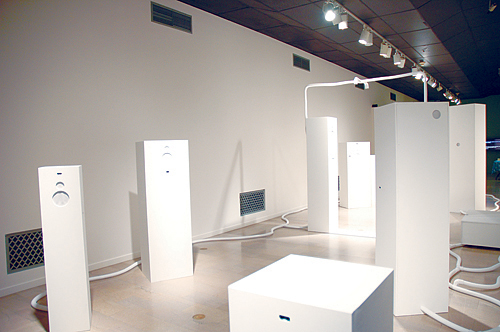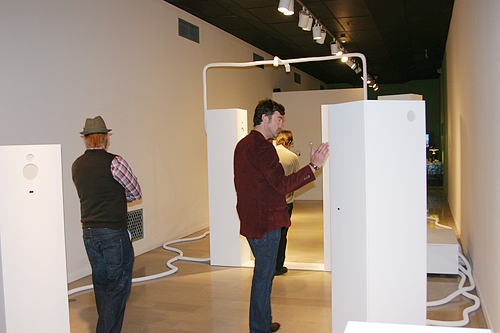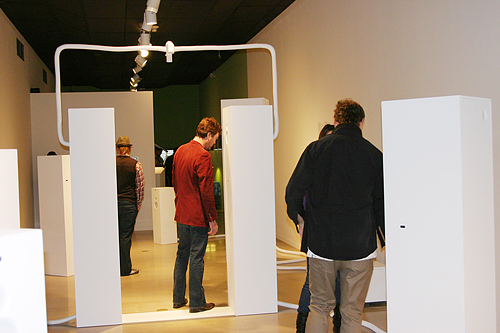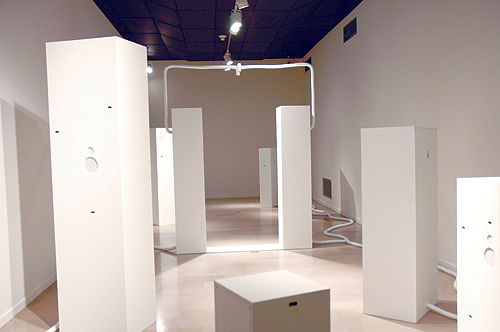New
installation for particle group, in Inside
the Wave
San Diego Museum of Art, through June 22, 2008
"For the market, nanoparticles hold the 21st century’s great promise. For critics,
they are a vision of pure horror, as long as the toxicological risks
are not known. The era of unregulated nanocapitalism has already dawned..." (read
more from the PITMM site).
Starting with some of the narratives produced through Ricardo Dominguez
and Diane Ludin's PITMM project, I created this interactive
installation, hoping to translate some of the hype and hidden penetration
of nanotechnology into an experiential tug-of-war.
Here are links to recent articles about the work:
San
Diego Union Tribune review of Inside the Wave
San Diego City Beat discusses Inside
the Wave
Street: San
Diego Union Tribune blogs on the piece
San Diego Museum of Art Inside the Wave info
And here is some video documentation - it may need to be fully downloaded before sound and image sync up, and is best heard through headphones or external speakers:
PITMM at SDMA short documentation
This is a new site-specific cousin to the nano installation I made for
Berlin's House of World Cultures.
In both versions, as visitors move through the installation, they tune the soundscape
with their bodies. If a visitor simply passes by a pedestal, or stands in front
of it, she triggers a particular mix of sound played in a particular
way. But if her curiosity leads her to spend more time and play with the visible
sensors - if she moves closer and further from the sensor "eyes" - she gains
controls over the sound. She can slow or speed it up, dissolve and fracture texts,
mix in new sounds that contradict or harmonize with key narratives, or unfurl
longer, stranger nanotales and nanodogma. The piece becomes something that
can be played, not just heard. Blasts of air interrupt this process, repelling
some visitors, but not before blowing particles and sucking visitors' surface
cells into our nano-sonic exchange. At times, particle sounds swirl through speakers,
swarming and surrounding the visitors. (see the
video of the Berlin version to get
an idea of how this works).
Theorist Brian Massumi has described the human body as a collection of transducers.
(transducer,
n., a device that is actuated by power from one system and supplies power usually
in another form to a second system.) My work mines bodily transduction circuits - the physical, sonic and logical circuits imposed on bodies moving through today's scripted spaces. I’m particularly interested in creating choreographies that generate awareness through the body's parallel processing of related scripts through multiple senses.
Thus in designing the piece for the San Diego museum, it became interesting to
me to intertwine 5 key scripts at play in that particular space, to see what
kinds of gaps and overlaps might come up by mashing up old and new systems of
control. These systems are: 1) The classic museum scripting of a body's movement
through galleries - a choregraphy that physically circulates a visitor so that
she might receive Important Cultural Ideas and Objects. 2) The scripts and expectations
attached to the pedestal as form - how we place ourselves and behave in relation
to a pedestal and its "contents" -
versus the slightly different dance encouraged between pedestals and visitors
to our piece. 3) Controls imposed by the central nervous system of the museum
- the electrical and air circulation systems. The tubes through which our piece
circulates air and information are visibly connected to the inputs/outputs of
this museum infrastructure. 4) Nanotechnology's invasive scripting of the body
- it's invisible penetration of the body's surface and interior, in order to
perform scripts both known and unknown. 5) Sound's similar meeting and
scripting of the body, through its invisible penetration of the body's surfaces
and interiors.
What kind of agency might a visitor feel being lost and/or created in this heavily
scripted, but not atypical, contemporary space? The visitor might seem to gain
more controls as she moves through the piece. A wider range of sounds & manipulations
become available as she proceeds. But in order to gain "control", she
offers more of her body/time to the interests of the system. A visitor who invests
the most time & curiosity in the piece finds hidden sweet spots that provide
alternative texts and sounds. But in taking the time to find these sweet spots,
she is continuously offering her body to be read and experimented upon by the
system....
We are so often lured into giving up agency through this very illusion of increasing
our "control".
The scripted system captures and imparts all it wants, while we frequently gain
but a facade of control over its surface effects...
But there are opportunities for hacking. The pedestals can be played as sound
instruments - defying the logical sense of the information they attempt to impart.
And you see marks of peoples hands and feet on the white pedestals - disruptions
of obedient museum visitor standard practice. The marks point to experiences
that can't be seen - visible traces of invisible actions that run counter to
our nano-script, hackable soft spots in the dominant
narrative.
The installation is currently open to visitors
to the museum and has been used in performances by Ricardo Dominguez,
Amy Sara Carroll and Césaire José Carroll-Dominguez.
Project Credits:
Principal Investigators: Ricardo Dominguez and Diane Ludin
Interactive Sound Installation: Nina Waisman
PD programming: Marius Schebella
Installation construction: Pierre Galaud, Robert Twomey, Nina Waisman
Voices: Veronika Bauer, Nevllle Billimoria, Philipp Danzeisen, Ricardo Dominguez,
Laura Booth Freda, Karina Gutierrez, Felipe Zuniga
Special thanks to:
Betti-Sue Hertz
Calit2
PITMM
Site



